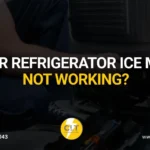[TL;DR]
“Smart home appliances are transforming repair services in 2025 through built-in diagnostics, remote troubleshooting, and predictive maintenance. This guide explores how connected devices enable faster problem identification, software-based fixes, and require new technical skills from repair professionals. Learn the benefits and challenges of smart appliance repairs and why choosing experienced service providers like CLT Appliance matters.”
Smart refrigerators now text you when they break. Washing machines diagnose themselves before calling for help. This is 2025, where smart home appliances repair has transformed from guesswork into precise, data-driven solutions!
The appliance repair industry is experiencing its biggest revolution since electricity replaced manual labor. Smart appliances communicate problems instantly, enable remote diagnostics, and often fix themselves through software updates. This transformation is accelerating rapidly, with smart appliance households expected to reach 643.9 million users globally by 2029.
Struggling with a smart appliance that’s acting up? Our expert team at CLT Appliance Repair specializes in smart diagnostic technology and smart device expertise that gets your connected home running smoothly again.
Connect with the Experts: 704-606-9043
The Rise of Smart Home Appliances in 2025
Smart appliances now dominate modern homes through internet connectivity, artificial intelligence, and sensor technology. These devices learn user preferences, optimize performance automatically, and communicate with other smart home systems.
Popular smart appliances transforming homes include:
- Refrigerators with internal cameras and inventory management
- Washing machines that adjust cycles based on fabric sensors
- Smart ovens with precise temperature control and recipe integration
- HVAC systems with learning thermostats and remote monitoring
- Dishwashers that optimize water usage and detect loading patterns
Key features driving adoption include voice control integration, smartphone app connectivity, energy efficiency monitoring, and predictive maintenance alerts. Consumers expect seamless integration with existing smart home ecosystems and intuitive user interfaces.
Revenue in the smart appliances market is projected to reach $68.7 billion in 2025, with annual growth rates of 9.81% through 2029, reflecting massive consumer adoption of connected home technology.
How Smart Appliances Change The Way Repairs Are Done?
Smart technology fundamentally transforms repair processes through real-time monitoring, remote diagnostics, and predictive analytics. Traditional reactive repair models give way to proactive maintenance and prevention strategies.
1. Built-in Diagnostics and Early Issue Detection
Smart appliances use multiple sensors to track temperature, vibration, water pressure, electrical consumption, and operational cycles. These sensors create baseline performance profiles and immediately flag deviations that indicate potential problems.
Automatic error reporting systems notify homeowners through smartphone apps while simultaneously alerting authorized repair services. This dual notification ensures faster response times and prevents minor issues from becoming major failures.
Early detection capabilities include:
- Temperature fluctuations in refrigeration systems
- Unusual vibration patterns in washing machines
- Blocked filters or ventilation issues in HVAC units
- Electrical anomalies that could indicate component failure
- Water leak detection in dishwashers and washing machines
2. Remote Troubleshooting and Software Updates
Many smart appliance issues are resolved through remote diagnostics and over-the-air software updates. Technicians access appliance diagnostic data remotely through secure internet connections. This capability allows problem identification, basic troubleshooting, and software-based repairs without scheduling onsite visits.
Over-the-air updates fix software bugs, improve energy efficiency, add new features, and resolve compatibility issues. These updates often eliminate the need for service calls while keeping appliances current with the latest technology improvements.
Moreover, remote capabilities enable technicians to guide homeowners through simple fixes, verify repair completion, and ensure optimal appliance performance before closing service tickets.
3. Data Analytics for Faster Problem Identification
Appliance data shows usage patterns, performance trends, and failure modes that help technicians prepare appropriate tools, parts, and solutions before arriving onsite. This preparation dramatically reduces diagnostic time and improves first-visit resolution rates.
Predictive maintenance algorithms analyze historical data to identify appliances approaching failure points. This early warning system enables scheduled maintenance that prevents emergency breakdowns and extends appliance lifespan.
New Skills Required for Appliance Repair Technicians
Today’s professionals combine traditional repair knowledge with digital technology expertise and cybersecurity awareness.
Combination of Mechanical and Digital Expertise
Smart appliance repairs require understanding both physical components and digital systems that control them. Technicians troubleshoot mechanical failures alongside software glitches and connectivity issues.
Traditional repair skills remain essential for replacing pumps, motors, heating elements, and mechanical components. However, technicians now also diagnose network connectivity problems, software conflicts, and sensor calibration issues.
Essential dual expertise includes:
- Mechanical component repair and replacement
- Network troubleshooting and WiFi connectivity
- Software diagnostic tools and update procedures
- Sensor calibration and replacement techniques
- Integration with smart home systems and voice assistants
Importance of Ongoing Training and Certification
Appliance manufacturers provide specialized training programs covering new features, diagnostic procedures, and repair protocols. These certifications validate technician competency with specific brands and models.
Technology changes require frequent training updates covering new connectivity standards, security protocols, and diagnostic software. Professional repair companies invest heavily in ongoing education to maintain service quality and customer satisfaction.
4 Top Benefits to Customers from Smart Appliance Repair Services
Here are the key advantages that smart appliance technology brings to repair experiences and customer satisfaction.
-
Faster Problem Resolution and Reduced Downtime
Smart appliances identify issues before complete failures occur, allowing repairs to be scheduled proactively rather than reactively. This predictive approach reduces emergency breakdowns by up to 60% while ensuring repairs happen during convenient timeframes rather than during household emergencies.
-
Enhanced Convenience and Communication
Remote diagnostic capabilities eliminate unnecessary service calls while providing flexible scheduling based on real-time technician availability. Customers receive continuous updates through smartphone notifications, automatic parts ordering that reduces delays, digital service records accessible anytime, and virtual consultations for simple troubleshooting issues.
3. Cost Savings Through Preventive Maintenance
Smart appliances enable predictive maintenance that prevents major component failures and extends appliance lifespan. Data analytics help identify optimal service intervals, with research showing that 97% of smart home device owners report satisfaction due to improved reliability and reduced unexpected repair expenses.
4. Seamless Service Experience
Smart appliances maintain basic functionality even during partial failures, reducing household disruption while repairs are scheduled. Enhanced communication provides complete transparency about diagnostic findings, repair progress, and digital documentation for warranty claims.
Challenges in Repairing Smart Home Appliances
Proprietary software systems limit repair access to authorized technicians who possess manufacturer-specific diagnostic tools and security credentials. This restriction can delay repairs when specialized technicians aren’t immediately available.
Data privacy and cybersecurity considerations require careful handling of customer information stored within smart appliances. Repair procedures must protect personal data while maintaining device functionality and security protocols.
Supply chain challenges include:
- Limited availability of specialized electronic components
- Higher costs for smart-enabled replacement parts
- Longer lead times for manufacturer-specific modules
- Compatibility requirements with existing home networks
- Version-specific software and firmware dependencies
Managing these challenges requires repair services to maintain extensive parts inventories, invest in manufacturer relationships, and develop expertise across multiple smart appliance platforms and brands.
Bottom Line
While other repair companies struggle to understand your smart refrigerator error codes, CLT Appliance Repair speaks fluent “smart appliance.” We’ve invested in the training, tools, and technology that other repair services skip. Our certified technicians carry manufacturer-approved diagnostic equipment that communicates directly with your smart appliances.
We are known for our specialized training, advanced diagnostic tools, and ongoing certifications for every major smart appliance brand. This means we arrive knowing exactly what’s wrong and how to fix it properly the first time.
Your smart appliances deserve repair professionals who are just as intelligent. Call CLT Appliance Repair today and finally get the expert service your connected home was meant to have!
Frequently Asked Questions
How are smart home appliances different from traditional appliances when it comes to repairs?
Smart appliances require technicians with digital expertise beyond mechanical skills. They involve network connectivity, software diagnostics, remote troubleshooting capabilities, and specialized manufacturer tools for proper repair completion.
Can smart appliances be repaired remotely without a technician visiting my home?
Many smart appliance issues are resolved through remote diagnostics and software updates. However, mechanical component failures, sensor replacements, and hardware problems typically require onsite technician visits for proper repair.
What common problems do smart appliances face that require professional repair?
Common issues include WiFi connectivity problems, software glitches, sensor malfunctions, app integration failures, firmware update problems, and mechanical component failures that affect smart functionality and performance.
Are smart appliance repairs more expensive than traditional appliance repairs?
Smart appliance repairs may cost more due to specialized parts and required technical expertise. However, remote diagnostics and predictive maintenance often reduce overall repair costs by preventing major failures.
How can I maintain my smart appliances to reduce repair needs?
Keep software updated, maintain stable WiFi connections, clean sensors regularly, follow manufacturer maintenance schedules, monitor app notifications for issues, and address problems promptly before they worsen significantly.
What should I consider when choosing a repair service for smart appliances?
Look for manufacturer certifications, smart technology expertise, remote diagnostic capabilities, transparent pricing, positive customer reviews, and technicians trained in both mechanical and digital appliance systems.
Author

- John Bennett
- John Bennett is a seasoned appliance repair specialist at CLT Appliance Repair, where he brings over a decade of technical expertise and a strong commitment to customer satisfaction. With a background in electrical and mechanical systems, John has built a reputation for reliable, efficient, and honest repair services across a wide range of household appliances-including refrigerators, washing machines, ovens, and more.







